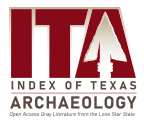Home > Research Projects and Centers > Center for Regional Heritage Research > Index of Texas Archaeology > Vol.
Agency
Journal of Northeast Texas Archeology
DOI
https://doi.org/10.21112/.ita.2016.1.84
Abstract
The Cherokee Lake site (41RK132), also called the Tiawichi Creek Burial site, was discovered by Buddy Calvin Jones in 1956, on a terrace area along Tiawichi Creek at its confluence with Mill Creek, inundated by the construction of Lake Cherokee in 1947, that had been graded for the construction of fish hatcheries there. Tiawichi Creek is a tributary stream in the mid–Sabine River basin. Jones identified a single burial and a large storage pit in Area A at the southern end of the terrace, where there was a shallow (0–30 cm bs) midden deposit.
The burial in Area A is an Historic Nadaco Caddo grave that probably dates to the early 18th century based on the recovery of 15 blue glass beads. This strand of beads was placed near the legs of the deceased individual. The Caddo person had been placed in an extended supine position in a pit that was 1.83 m long and 0.76 cm in width, with the head facing towards the west. The estimated depth of the grave was 0.76 m, and its fill was a dark charcoal–stained midden.
In addition to the strand of glass beads, three ceramic vessels had been placed as funerary offerings in the grave along with a Fresno arrow point by the upper left leg. One Simms Engraved vessel was on the left side of the body, near the foot of the grave, while a second Simms Engraved vessel had been placed by the individual’s right foot, along with a Maydelle Incised jar. A plain clay elbow pipe had been placed inside the jar.
A storage pit excavated by Jones in Area A at the Cherokee Lake site appears to have been primarily associated with a pre–A.D. 1200 Caddo occupation, based on the recovery of Hickory Engraved and Dunkin Incised pottery sherds, long–stemmed Red River clay pipe sherds, and Catahoula, Alba, and Bonham arrow points. This occupation probably created the midden deposits found in Area A.
In this article, I discuss ceramic sherds collected by Jones from Area A at the Cherokee Lake site. Some of the sherds were surface collected in March 1956 from the midden deposits, but it is not clear if this ceramic sherd assemblage is part of the sample of 300 sherds discussed by Jones from an Area A surface collection. The present ceramic sherd assemblage is curated at the Gregg County Historical Museum (GCHM).
Creative Commons License

This work is licensed under a Creative Commons Attribution-NonCommercial 4.0 International License
Included in
American Material Culture Commons, Archaeological Anthropology Commons, Environmental Studies Commons, Other American Studies Commons, Other Arts and Humanities Commons, Other History of Art, Architecture, and Archaeology Commons, United States History Commons
Tell us how this article helped you.


